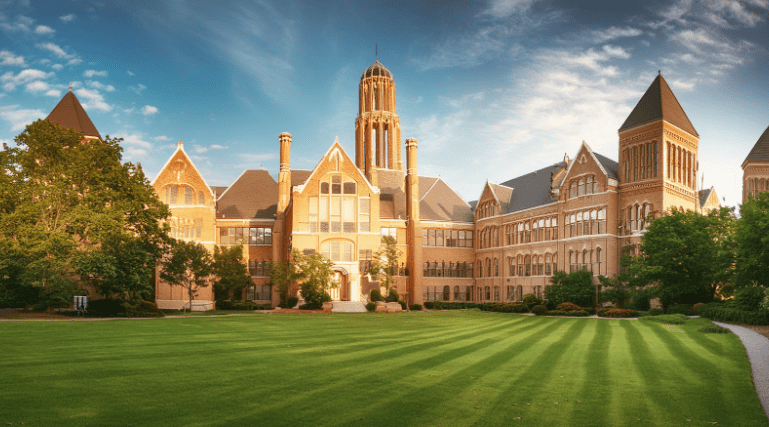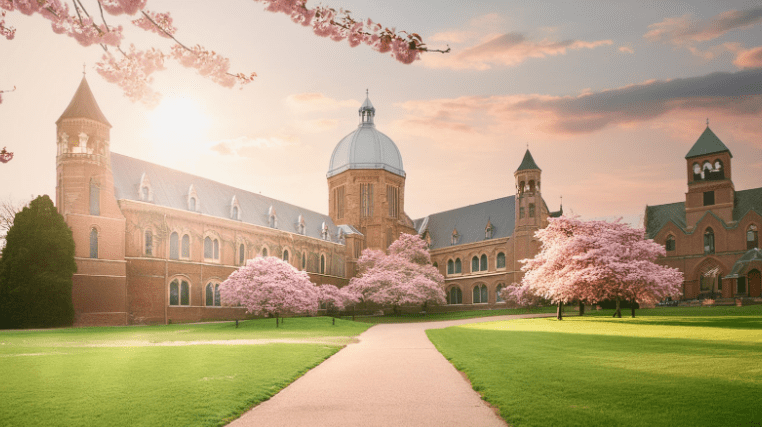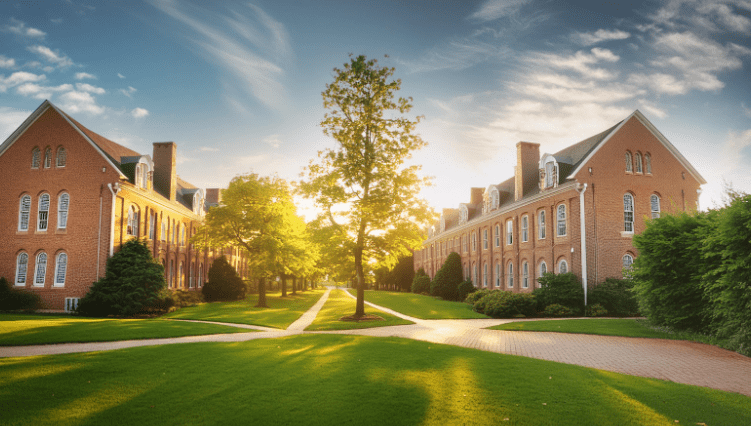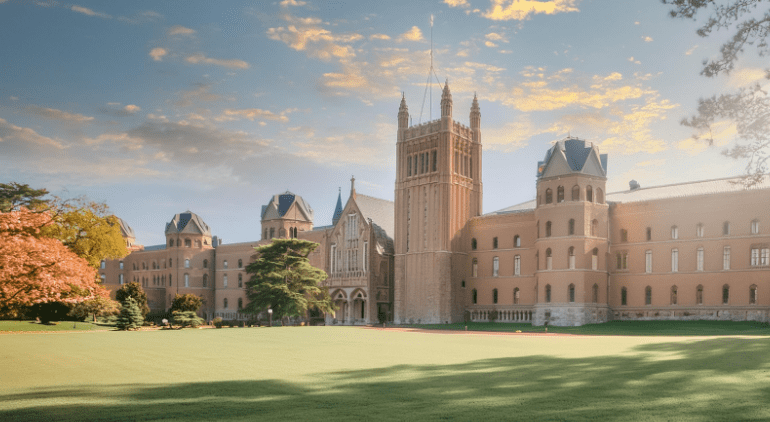For many students, the size of the college or university they will attend is a significant factor when choosing schools. Universities can range from a few hundred to tens of thousands of students in attendance.
The biggest colleges in the US draw students in because of the unique experiences that come from attending a school that is large enough to be a town itself. These decisions can impact students in ways that influence them for the rest of their lives.
In this post, we‘ll explore where the largest colleges in the US are located, what makes them stand out, and just how big they really are. Whether you’re considering applying or simply curious, get ready to discover the giants of American higher education!
Top 100 Biggest Colleges and Universities in the US
| Rank | College Name | Undergraduate Enrollment |
| 1 | Western Governors University | 54735 |
| 2 | Texas A&M University | 43531 |
| 3 | Ohio State University | 41117 |
| 4 | Penn State | 39520 |
| 5 | Arizona State University | 38212 |
| 6 | University of Central Florida | 37661 |
| 7 | Ashford University | 37066 |
| 8 | University of Texas – Austin | 36565 |
| 9 | Michigan State University | 35645 |
| 10 | Rutgers University | 33392 |
| 11 | University of Illinois at Urbana-Champaign | 31989 |
| 12 | Indiana University – Bloomington | 31728 |
| 13 | California State University – Northridge | 30281 |
| 14 | University of Florida | 30168 |
| 15 | University of Arizona | 29597 |
| 16 | Florida State University | 29185 |
| 17 | University of Minnesota – Twin Cities | 29168 |
| 18 | University of California – Los Angeles | 29004 |
| 19 | Iowa State University | 28771 |
| 20 | University of Alabama | 28689 |
| 21 | Purdue University | 28682 |
| 22 | University of Wisconsin | 28555 |
| 23 | University of Washington | 28377 |
| 24 | California State University – Long Beach | 27829 |
| 25 | Liberty University | 27671 |
| 26 | University of California – Davis | 27453 |
| 27 | Texas State University | 27369 |
| 28 | Brigham Young University | 27339 |
| 29 | University of Michigan – Ann Arbor | 27258 |
| 30 | California State University – Fullerton | 27105 |
| 31 | University of California – Berkeley | 26622 |
| 32 | Texas Tech University | 26121 |
| 33 | University of Missouri | 26027 |
| 34 | San Diego State University | 26010 |
| 35 | University of California – San Diego | 25922 |
| 36 | University of Georgia | 25906 |
| 37 | Florida International University | 25638 |
| 38 | Ivy Tech Community College – Central Indiana | 25614 |
| 39 | University of Maryland – College Park | 25410 |
| 40 | Temple University | 25318 |
| 41 | University of Colorado – Boulder | 25059 |
| 42 | University of North Texas | 24918 |
| 43 | University of Houston | 24912 |
| 44 | University of California – Irvine | 24854 |
| 45 | Virginia Tech | 24841 |
| 46 | Miami Dade College | 24716 |
| 47 | New York University | 24480 |
| 48 | University of South Florida | 24088 |
| 49 | University of South Carolina | 23613 |
| 50 | Louisiana State University | 23602 |
| 51 | San Francisco State University | 22206 |
| 52 | California State University – Sacramento | 22165 |
| 53 | San Jose State University | 21638 |
| 54 | Northern Arizona University | 21494 |
| 55 | Washington State University | 21384 |
| 56 | University of Kentucky | 21199 |
| 57 | University of Massachusetts – Amherst | 21098 |
| 58 | North Carolina State University | 21023 |
| 59 | University of Cincinnati | 21017 |
| 60 | Montclair State University | 21000 |
| 61 | Colorado State University | 20769 |
| 62 | University of Tennessee | 20569 |
| 63 | West Virginia University | 20532 |
| 64 | California State University – Los Angeles | 20380 |
| 65 | University of California – Santa Barbara | 20243 |
| 66 | University of Texas – San Antonio | 20234 |
| 67 | Southern New Hampshire University | 20193 |
| 68 | Virginia Commonwealth University | 20137 |
| 69 | University of Iowa | 19911 |
| 70 | University of North Carolina at Charlotte | 19765 |
| 71 | Auburn University | 19738 |
| 72 | California State Polytechnic University – Pomona | 19615 |
| 73 | University of Arkansas | 19607 |
| 74 | Grand Valley State University | 19376 |
| 75 | East Carolina University | 19336 |
| 76 | California Polytechnic State University – San Luis Obispo | 19318 |
| 77 | Kent State University | 19207 |
| 78 | University of Nebraska – Lincoln | 18817 |
| 79 | Georgia State University | 18813 |
| 80 | Lone Star College System | 18683 |
| 81 | California State University – Fresno | 18671 |
| 82 | University of Oregon | 18630 |
| 83 | Oregon State University | 18493 |
| 84 | University at Buffalo, SUNY | 18452 |
| 85 | Northern Virginia Community College | 18435 |
| 86 | James Madison University | 18433 |
| 87 | George Mason University | 18430 |
| 88 | Oklahoma State University | 18347 |
| 89 | University of Wisconsin – Milwaukee | 18316 |
| 90 | University of California – Riverside | 18279 |
| 91 | University of Southern California | 18208 |
| 92 | University of Oklahoma | 18133 |
| 93 | University of Connecticut | 18131 |
| 94 | CUNY Borough of Manhattan Community College | 18074 |
| 95 | Kansas State University | 17935 |
| 96 | Full Sail University | 17890 |
| 97 | University of Pittsburgh | 17887 |
| 98 | Kennesaw State University | 17732 |
| 99 | Central Michigan University | 17669 |
| 100 | University of North Carolina at Chapel Hill | 17645 |
When talking about the biggest schools in the country, there are several top contenders. If you’ve got your heart set on attending a big college, you might want to consider one of the following schools:
#1. Arizona State University | 145,655 students
Video: A Journey That Can Take You Anywhere
Arizona State University, founded in 1885, is a renowned public research university located in the Phoenix metropolitan area. It is known for its innovative approach to education and commitment to excellence.
The university offers a wide range of academic programs with a focus on areas such as business, biology, psychology, computer science, and finance. Notable alumni include Jimmy Kimmel, Phil Mickelson, Kate Spade, and Doug Ducey.
- Total 2023 enrollments: 145,655 students
- Address: 1151 S Forest Ave, Tempe, AZ, United States
- Avg cost after aid: $13,000
- Graduation rate: 66%
- Acceptance rate: 90%
#2. Penn State University | 87,903 students
Video: There's something about Penn State.
Penn State University, established in 1855, is a major public research institution. It serves Pennsylvania and the global community with diverse academic programs and research. The university focuses on academic excellence, innovation, and community impact.
Penn State offers majors in agriculture, engineering, business, and social sciences. It is known for producing notable alumni like Lara Spencer, Ty Burrell, Mark Parker, and Guion Bluford.
- Total 2023 enrollments: 87,903 students
- Address: 201 Old Main, University Park, PA 16802, United States
- Avg cost after aid: $19,835
- Graduation rate: 73%
- Acceptance rate: 55.2%
#3. Texas A&M University | 77,491 students
Video: Discover What Different Does | Texas A&M University Commercial 2023
Texas A&M University, a public, land-grant research university in College Station, Texas, traces its origins back to its founding in 1876.
Over the years, it has evolved into the flagship institution of the Texas A&M University System, with a strong emphasis on academic excellence and research.
The university offers a diverse range of majors, including engineering, business, law, and health sciences. Some notable alumni from Texas A&M University are Johnny Manziel, Brittany Broski, Alex Caruso, and Hassan Diarra.
- Total 2023 enrollments: 77,491 students
- Address: College Station, TX, United States
- Avg cost after aid: $21,000
- Graduation rate: 81%
- Acceptance rate: 63%
#4. University of Central Florida | 69,320 students
Video: UCF Traditions | The College Tour
The University of Central Florida (UCF) is a public research university established in 1963 with its main campus located in unincorporated Orange County, Florida.
Known for its commitment to innovation and excellence, UCF offers a broad spectrum of academic programs across various disciplines.
Major areas of study include engineering, hospitality management, healthcare, digital media, and psychology. Notable alumni from UCF include Cheryl Hines, Daniel Tosh, Plies, Jeffrey Michael Jordan.
- Total 2023 enrollments: 69,320 students
- Address: 4000 Central Florida Blvd, Orlando, FL, United States
- Avg cost after aid: $9,217
- Graduation rate: 76%
- Acceptance rate: 41%
#5. Rutgers University, New Brunswick | 67,200 students
Video: Rutgers Day 2023
Rutgers University, officially known as Rutgers, The State University of New Jersey, is a prestigious public land-grant research university with a history dating back to 1766.
As one of America's leading public research universities, Rutgers is known for its diverse academic programs and research activities. The core proposition of Rutgers University lies in its commitment to academic excellence, innovation, and community impact.
Major majors at Rutgers University include but are not limited to arts and sciences, engineering, business, social sciences, and health professions. Some notable alumni from Rutgers University include Carli Lloyd, Kristin Davis, James Gandolfini, and Roy Scheider.
- Total 2023 enrollments: 67,200 students
- Address: New Brunswick, NJ, United States
- Avg cost after aid: $15,000
- Graduation rate: 84%
- Acceptance rate: 66%
#6. Ohio State University | 65,405 students
Video: Welcome to Ohio State!
The Ohio State University (OSU), founded in 1870, is a prominent public land-grant research university located in Columbus, Ohio. Known for its rich history and dedication to research and education, OSU offers a diverse array of academic programs across various fields.
Major areas of study at OSU include healthcare, engineering, business, psychology, and education. Notable alumni from OSU include George Steinbrenner, Kirk Herbstreit, Jack Nicklaus, and Roy Lichtenstein.
- Total 2023 enrollments: 65,405 students
- Address: 281 W Lane Ave, Columbus, OH, United States
- Avg cost after aid: $19,000
- Graduation rate: 86%
- Acceptance rate: 53%
#7. New York University | 61,950 students
Video: NYU Tandon | Meet NYU Campus Tour
New York University (NYU), established in 1831, is a prestigious private institution known for its academic excellence and diverse student body. Situated in New York City, NYU offers a wide range of programs and is committed to providing top-quality education.
The university offers majors such as arts, humanities, health professions, and many more. Notable alumni from NYU include Elizabeth Swados, Shaina Taub, and many others who have made significant contributions in their respective fields.
- Total 2023 enrollments: 61,950 students
- Address: New York, New York, United States
- Avg cost after aid: $40,000
- Graduation rate: 85%
- Acceptance rate: 12%
#8. University of Washington | 60,692 students
Video: UW Campus Tour: Hear It from a Husky
Founded in 1861, the University of Washington (UW) is a prominent public institution known for its academic excellence and research contributions. Situated in Seattle, Washington, UW offers a diverse range of undergraduate and graduate programs across various fields.
Major majors at UW include research and experimental psychology, computer science, econometrics and quantitative economics, speech communication and rhetoric, and political science and government.
Notable alumni of the University of Washington include Markelle Fultz, Kelsey Plum, Puka Nacua, and Troy Fautanu.
- Total 2023 enrollments: 60,692 students
- Address: Seattle, Washington, United States
- Avg cost after aid: $10,933
- Graduation rate: 83%
- Acceptance rate: 48%
#9. University of Florida | 60,489 students
Video: Always Forward
The University of Florida, founded in 1853, stands as a prestigious public land-grant research university in Gainesville, Florida. With a legacy of academic excellence and research innovation, it offers a diverse range of undergraduate programs in various disciplines. .
Major majors at the University of Florida include psychology, biology, business administration, political science, and computer and information sciences. Notable alumni from the University of Florida include Erin Andrews, Faye Dunaway, Emmitt Smith, and Stephen M. Ross.
- Total 2023 enrollments: 60,489 students
- Address: Gainesville, FL, United States
- Avg cost after aid: $3,679
- Graduation rate: 88%
- Acceptance rate: 23%
#10. University of Illinois Urbana-Champaign | 56,403 students
Video: Progress isn't Quiet at Illinois
University of Illinois Urbana-Champaign, a public land-grant research university, was established in 1867 and is a world leader in research, teaching, and public engagement.
With a focus on academic excellence and innovation, the university offers a wide range of undergraduate and graduate programs across diverse fields.
Key majors at the university include research and experimental psychology, accounting, computer engineering, cell/cellular and molecular biology, and finance.
Notable alumni from the University of Illinois Urbana-Champaign include Max Levchin, Marc Andreessen, Jack Welch, and Jawed Karim.
- Total 2023 enrollments: 56,403 students
- Address: Champaign-Urbana metropolitan area, Illinois, United States
- Avg cost after aid: $15,483
- Graduation rate: 85%
- Acceptance rate: 45%
#11. University of Minnesota Twin Cities | 54,890 students
Video: University of Minnesota System
The University of Minnesota Twin Cities, a public land-grant research university founded in 1851, proudly serves as the flagship campus of the University of Minnesota System.
Renowned for its commitment to academic excellence and research, the institution offers a wide range of undergraduate and graduate programs.
Key majors at the University of Minnesota Twin Cities encompass a variety of fields like science, engineering, business, social sciences, and liberal arts. Notable alumni include Jessica Lange, Henry Fonda, Walter F. Mondale, and Hubert Humphrey.
- Total 2023 enrollments: 54,890 students
- Address: Minneapolis and Falcon Heights, Minnesota, United States
- Avg cost after aid: $17,000
- Graduation rate: 83%
- Acceptance rate: 75%
#12. Florida International University | 54,085 students
Video: FIU Commercial "Moments"
Florida International University (FIU), established in 1972, is a leading public institution located in Miami, Florida, known for fostering talent and innovation locally and globally. FIU offers a wide range of undergraduate and graduate programs with a focus on excellence in education.
Major areas of study at FIU include business, engineering, healthcare, computer science, and international relations. Notable alumni from FIU include Danny Pino, Aimee Carrero, Andy Garcia, and Dawn Ostroff.
- Total 2023 enrollments: 54,085 students
- Address: 11200 SW 8th St, Miami, FL, United States
- Avg cost after aid: $6,232
- Graduation rate: 74%
- Acceptance rate: 64%
#13. Northern Virginia Community College | 53,810 students
Video: NOVA - We Make College Better
Northern Virginia Community College (NOVA), established in 1965, serves as a prominent public community college spanning six campuses and four centers in Northern Virginia suburbs near Washington, D.C.
NOVA is renowned for its accessibility, high-quality programs, and diverse student population. The core proposition of NOVA lies in offering a wide array of academic programs while providing extensive support to ensure student success.
Main majors encompass varied fields such as business administration, accounting, biology, and art history. Notable alumni include Candice Rose Martinez, Taliana Vargas, Ashley Wagner, and Doug Mills.
- Total 2023 enrollments: 53,810 students
- Address: Northern Virginia suburbs of Washington, D.C., Virginia, United States
- Avg cost after aid: $9,884
- Graduation rate: 34.9%
- Acceptance rate: 99%
#14. University of Texas at Austin | 53,082 students
Video: It Starts Here
The University of Texas at Austin, established in 1883, stands as a prestigious public institution known for its commitment to academic excellence and research innovation.
With a rich history, it offers a wide array of undergraduate and graduate majors, including business, engineering, law, healthcare, and social sciences.
Notable alumni from the University of Texas at Austin include Matthew McConaughey, Farrah Fawcett, Rex Tillerson, and Allen Ludden.
- Total 2023 enrollments: 53,082 students
- Address: Austin, TX, United States
- Avg cost after aid: $18,000
- Graduation rate: 85%
- Acceptance rate: 31%
#15. Purdue University, West Lafayette | 52,211 students
Video: Discover a day in the life at Purdue
Purdue University, established in 1869, is a renowned public research university located in West Lafayette, Indiana. Known for its advancements in science, technology, engineering, and math, Purdue maintains a strong focus on innovation and discovery.
The university offers a wide array of majors, including business administration and management, computer science, mechanical engineering, information technology, and aerospace engineering.
Notable alumni from Purdue University include Neil Armstrong, Gene Cernan, Drew Brees, and Gus Grissom.
- Total 2023 enrollments: 52,211 students
- Address: West Lafayette, Indiana, United States
- Avg cost after aid: $9,127
- Graduation rate: 82%
- Acceptance rate: 53%
#16. University of Michigan | 52,065 students
Video: Summer At the University of Michigan: Campus Tour
The University of Michigan, founded in 1817, stands as a prestigious public research university located in Ann Arbor, Michigan.
It boasts a tradition of excellence in research, learning, teaching, sports, and the arts. The university's core proposition revolves around fostering academic excellence and innovation.
Offering a wide range of majors, including mechanical engineering, business administration, computer science, and architecture, the University of Michigan has produced notable alumni such as Lawrence Wong, Joe Milton III, and Dylan McCaffrey.
- Total 2023 enrollments: 52,065 students
- Address: Ann Arbor, Michigan, United States
- Avg cost after aid: $17,086
- Graduation rate: 93%
- Acceptance rate: 18%
#17. Michigan State University | 51,316 students
Video: You Are a Spartan | Michigan State University Fall Welcome
Michigan State University (MSU), a public land-grant research university founded in 1855, is located in East Lansing, Michigan. Recognized for its academic rigor and research contributions, MSU offers a wide range of undergraduate and graduate programs.
Major areas of study at MSU include agriculture, natural resources, engineering, business, humanities, and social sciences. Notable alumni from Michigan State University include Magic Johnson, Kirk Gibson, Draymond Green, and Gretchen Whitmer.
- Total 2023 enrollments: 51,316 students
- Address: East Lansing, Michigan, United States
- Avg cost after aid: $11,000
- Graduation rate: 81%
- Acceptance rate: 88%
What Are the Pros of Attending the Biggest Colleges in the US?

If you were to attend the biggest college in the U.S., what would your undergrad years look like? While you can’t see the future, you can give yourself the best chance of success at school when you arm yourself with the most important information available.
More Resources
The largest schools in the country draw tens of thousands of students for many good reasons.
Larger schools typically offer more majors, more research opportunities, more student-run organizations, and the best faculty members in their respective fields.
A Wider Selection of Majors
If you aren’t sure about your future goals, a big university offers many opportunities for experimentation. If you are confident in your chosen major, you can still take advantage of the opportunities you find interesting to develop your skills and hone your talents.
Additional Networking and Job Opportunities
Large universities have bigger alumni networks, translating to more potential networking opportunities. This can often mean more job opportunities and internship programs, not to mention opportunities to study abroad.
More Experiences, More People
Attending the biggest school in the U.S. will also put you in the vicinity of a larger pool of people than a smaller school can. By meeting more new people, you will have the opportunity to expand your cultural horizons.
This also means you will be exposed to more intramural sports, social organizations, niche clubs, volunteer opportunities, and other extracurricular activities. Above all else, you will be able to make more new friends, too!
The Cons of Attending the Biggest Universities in the US

If you were to attend the biggest college in the U.S., what would be the negative aspects of that choice? The answer is different for everyone, of course. Still, there are some drawbacks of going to a big school that are somewhat more universal than others.
You Can Feel (and Get) Lost
In general, the bigger the school, the easier it will be for students to get lost — physically and figuratively. It generally isn’t as simple to navigate large campuses, and this opens up more possibilities for getting lost.
In addition, students who are more introverted, withdrawn, private, or hesitant to reach out and speak to others can find themselves getting “lost in the crowd,” figuratively speaking.
Less Attention from Faculty
With more students on campus naturally comes less personalized attention from professors.
Students who want a college that will allow them one-on-one attention from their teachers may not be happy with a university where many of the classes are held in 500-seat lecture halls.
Is a Large University Right for You?
Every college in America, from the smallest to the largest, has something unique to offer its students. A large university might be right for you if you are looking for the following:
- State-of-the-art research facilities
- Well-funded sports programs
- A wide array of housing options
- Many academic choices and student activities
- Well-equipped libraries
- Distinguished faculty
- Larger classes and lecture-hall setups
But What About Small Universities?

Choosing to attend a small college offers numerous benefits and advantages for students seeking a personalized and intimate learning experience.
With smaller class sizes, students have the opportunity to form close relationships with professors, fostering a supportive and engaging academic environment.
The individual attention received at small colleges allows for more personalized instruction, mentorship, and guidance, enabling students to fully explore their academic interests and excel in their chosen field of study.
Small colleges often provide a tight-knit community where students can develop lasting friendships and connections. The smaller student population promotes a sense of belonging and camaraderie, creating an inclusive and supportive social atmosphere.
Students at small colleges often have more opportunities to participate in extracurricular activities, student organizations, and leadership roles, as there is less competition for limited spots.
This involvement in campus life enhances personal growth, interpersonal skills, and the development of a well-rounded individual.
At small colleges, students have the advantage of easier access to resources and facilities.
With fewer students vying for the same resources, it becomes easier to secure research opportunities, internships, and access to specialized equipment and facilities. This hands-on experience provides invaluable practical skills and enhances future career prospects.
Moreover, the close relationships with faculty members can lead to strong recommendation letters, networking opportunities, and mentorship connections that can positively impact post-graduate endeavors.
Another significant benefit of attending a small college is the flexibility and adaptability it offers. Small colleges often have more flexible curriculum requirements, allowing students to customize their education to align with their unique interests and career goals.
Students have the opportunity to explore diverse subjects, engage in interdisciplinary studies, and pursue individualized research projects.
The flexibility in course selection and personalized attention from faculty enables students to receive a well-rounded education that caters to their specific aspirations and passions.
Attending a small college provides a host of benefits, including personalized attention, a supportive community, enhanced access to resources, and greater flexibility in shaping one’s education.
When considering higher education options, the unique advantages of small colleges should be carefully weighed to find the best fit for individual preferences and goals.
Bonus: Tips for Finding Your Best College in the US

Opting to attend a suitable college comes with a range of benefits and opportunities that can greatly enhance the college experience.
By following these tips, parents and children can make well-informed decisions and find the best colleges that fit their needs and aspirations:
- Start Early: Begin the college search process early to allow ample time for research and visits.
- Identify Interests: Help your child identify their academic and extracurricular interests to narrow down potential colleges.
- Consider Location: Think about the college's location, including climate, distance from home, and urban vs. rural settings.
- Research Programs: Look for colleges that offer strong programs in your child's intended major or field of interest.
- Visit Campuses: Schedule campus visits to get a feel for the environment, facilities, and overall vibe.
- Check Accreditation: Ensure the colleges are accredited by recognized accrediting agencies to guarantee quality education.
- Evaluate Class Sizes: Consider the student-to-faculty ratio and average class sizes to ensure personalized attention.
- Review Graduation Rates: Check the college's graduation and retention rates as indicators of student satisfaction and success.
- Assess Financial Aid: Research financial aid options, including scholarships, grants, and loans, to determine affordability.
- Explore Extracurriculars: Investigate the availability of clubs, sports, and other activities that match your child's interests.
- Read Reviews: Look for reviews and testimonials from current students and alumni to gain insights into their experiences.
- Consult Rankings: Use college rankings as a starting point, but don't rely solely on them; personal fit is more important.
- Talk to Advisors: Meet with high school counselors or college advisors for personalized guidance and recommendations.
- Consider Class Formats: Decide if your child prefers in-person, online, or hybrid classes and find colleges that offer those options.
- Plan Campus Visits: Attend open houses, information sessions, and virtual tours to gather more information about prospective colleges.
Learn more: How to Find the Best College Advisor for You | Empowerly
Ready to turn your college admission dreams into reality? Join the 98% of students who have worked with Empowerly and been accepted into Ivy League and top 25 schools.
Our college counselors are the best-rated in the country and have proven to improve college admission rates by 11x. Book your FREE consultation today.
